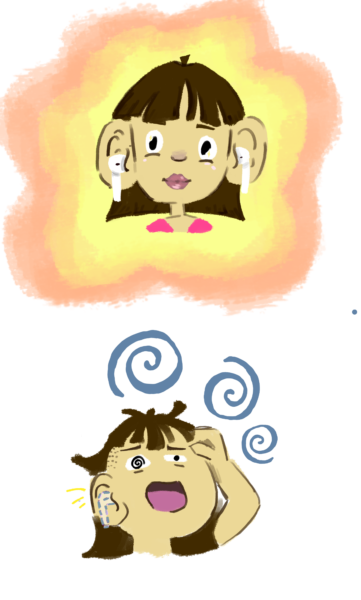
“What’s your favorite song?” and “Who’s your favorite musical artist?” are common icebreaker questions. Music is one of the most common topics when getting to know someone. It has been a way for people to bond and form connections. Every culture has its own unique music, and through technology, all different types of music have spread and evolved across the globe, becoming an integral part of many people’s identities.
“Metal is very cathartic,” said junior Leonidas Telfer-Mantouvalos. “[It’s] an outlet, especially if I feel angry at something … It affects how I dress [and] how I think. Metal is known for questioning authority, like religion.”
Many teenagers now use AirPods to listen to music, as they offer them a sense of safety and security in an uncomfortable environment.
“When [I’m] walking in the hallways. It feels awkward when [I’m] walking by [myself],” said junior Neeha Kumar. “Having AirPods in and having music on makes me feel like I’m still doing something, so I’m not as awkward, and I can be more confident.”
Music can lift people’s mood and make them feel more comfortable. However, with these positive effects of music, there are also negative ones like lowered focus.
That’s why many teachers have banned students from using AirPods in their classrooms, along with their phones as a result of concerns like not being fully present in class.
“When you’re with a group of people, [using AirPods] closes you off,” said Precalculus and Advanced Placement Calculus teacher Cheri Dartnell. “It isolates you. You lose a lot of the [collaboration] and conversations around the assignment.”
Before COVID-19, Dartnell didn’t see phones as much of an issue, but last year she made the decision to tighten the restrictions and usage of it. This year, she’s expanded it to earbuds and AirPods.
“[Students] got into a habit of a different routine … like having the TV on, having the music on in the background, during that year and a half,” Dartnell said. “That has carried over into the classroom because that’s the way they conducted themselves during the shutdown.”
Although many teachers ban AirPods and phones in class, many students enjoy listening to music while doing work outside of the classroom, as it helps them concentrate.
“I find that pop music is really good for listening to in the background while I’m doing homework,” Kumar
said. “I can disassociate and have it in the background as white noise.”
However, the type of work a student is doing also affects if they are listening to music.
“When I’m reading in English class … I’ll listen to music,” said senior Bridgette Martin. “I can read while listening to something [because] I already know the lyrics, so I’m not actively thinking about it.”
Humans are constantly bombarded with noise from the outside world when they are out and about, so sleep should be a solace from this noise overstimulation. Yet, many people continue to use noise to fall asleep. Kumar falls asleep watching the television show “Gilmore Girls” while Martin habitually falls asleep to music or Youtube gaming videos. While she doesn’t need the music or videos to fall asleep, she has
found that there are some ramifications.
“It’s affected how I dream,” said Martin. “I don’t think [I’ve] dreamed in the past couple years.”
The creation of headphones and accessibility of music and movies has altered the world’s soundscape, allowing for sound all the time, anytime.



